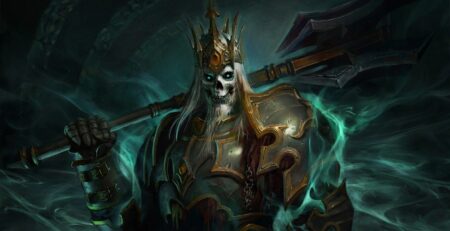Forever a master of magical realism, the prolific (and perhaps immortal) Hayao Miyazaki has never failed to ensnare audiences with his signature, eclectic brand of world-building. His soft, meticulous brushstrokes render even the most imaginative and bizarre elements truly immersive. Pioneering an aesthetic all his own, one that’s equal parts majestic and magnetic, it becomes all too easy to surrender to his sweeping current. It’s only fitting that the last spell Miyazaki (allegedly) casts with Studio Ghibli’s The Boy and The Heron is one that grapples with loss, finality, and legacy, and it does so in the only way he knows how: as a magisterial fantasy epic that doubles down on the wanton strangeness that has always permeated his craft.
From the mind of Hayao Miyazaki, The Boy and The Heron realizes itself as the work of an artist who has very little left to prove, as he takes his time to relish the environments and creatures he conjures, resulting in his unbridled creativity taking hold in ways that can, at times, be too iterative of his past—featuring yet another young protagonist slipping into a world unburdened by the laws of nature—but never short of breathtaking.
His first feature since 2013’s The Wind Rises, which was originally supposed to be his swan song, is already a hit in Japan, where it was released solely off the back of Miyazaki’s reputation, without any advance promotion to impact the theater box office. Its original Japanese and infinitely better title, “How Do You Live?”, taken from Genzaburo Yoshino’s 1937 semi-autobiographical fantasy novel, asks a pivotal question that has loomed over the better part of Miyazaki’s career but has never been reckoned with until now.
Using the Pacific theatre of World War II to ground the story, Miyazaki quickly acquaints the titular boy, Maki Mahito (Soma Santoki), with mortality as he loses his mother in a hospital firebombing. It’s a harrowing, ethereal opening awash with inky, still silhouettes that stand in stark contrast to the hurrying Mahito, who’s confronted with a figurative image of his mother succumbing to the flames.
Years after the tragedy, the young boy Mahito moves to a sprawling, dream-like estate in the countryside. Still besieged by grief, his father, like Miyazaki’s own, runs a factory that produces aircraft components and is newlywed to his former sister-in-law who is expecting. Mahito struggles to acclimate to his new setting, even a gaggle of lively grannies scurrying about the property, clamoring over newly arrived foodstuffs, fails to cheer him up. The arrival of an annoying but enticing heron only worsens the situation.

It’s here where The Boy and the Heron lingers a tad aimlessly, driven not by a desire to propel the plot but to allow the audience to soak in Mahito’s grief. It’s an impactful choice given force by Miyazaki’s decision to not have Mahito share his past protagonists’ intensity but instead be more reserved and emotionally distant. In much of his output, Miyazaki has catapulted audiences and characters directly into his world. Still, here he takes his sweet time, as if unhurried by the ticking clock over his head, relishing the beauty and serenity of the artmaking process.
That’s not to say the first half doesn’t awe and inspire. The mix of fluid lines and immaculate detail enables Miyazaki to evoke the intimacy of life while not being limited by it, enabling wide, verdant vistas to be just as expressive as his vivid close-ups. His settings often become characters unto themselves, and it’s no different here with the estate’s lone protruding tower guarding a portal to another world—Miyazaki’s vibrant take on an afterlife of sorts.
This section of the film is exactly what Ghibli fans signed up for, replete with Miyazaki Trademarks: anthropomorphic animals, physics-defying locales, and cute, pillowy critters like the Warawara. The latter of which ascend to the skies to be reborn as humans if they’re not viciously hunted by starving pelicans first. Like the greatest of Miyazaki films, grotesque brutality and endearing whimsy are but a few contours apart.
The Boy and the Heron also feature the most abstract mythos of any Ghibli film, and that quality is both a blessing and a curse. On one hand, Miyazaki throws everything at his canvas, creating some of the most indelible images and moments of his legendary oeuvre but on the other, the sheer randomness of it can be dizzying and tiresome. Miyazaki is no stranger to crafting a story on the go (employing this method in some of his greatest efforts) but there’s a haphazard quality to The Boy and the Heron that is hard to shake, often detracting as much as it uplifts.
Nonetheless, The Boy and the Heron is a mature, solemn, and bizarre meditation on loss and legacy, one that deems death to be a transitory act, a new beginning—and in that way, nothing really starts or ends. Instead, filmmaking—and life, for that matter— becomes a cyclical experience, which makes this potential swan song utterly fitting for an enduring artist like Miyazaki.
The Boy and the Heron screened as part of the 2023 Toronto International Film Festival and is playing now nationwide.
The Boy and the Heron
-
Rating - 8/108/10
TL;DR
The Boy and the Heron is a mature, solemn, and jubilant meditation on loss and legacy, one that deems death to be a transitory act, a new beginning—and in that way, nothing really starts or ends. Instead filmmaking—and life for that matter— becomes a cyclical experience, which makes this potential swan song utterly fitting for an enduring artist like Miyazaki.





